A Placemaking Journal
Remember that Katrina Cottages thing? Whatever happened to that?
 This is the second of two parts addressing Hurricane Katrina 10 years after the storm. The first looked at issues in New Orleans. This one focuses on one hoped-for innovation in the storm’s wake in Coastal Mississippi.
This is the second of two parts addressing Hurricane Katrina 10 years after the storm. The first looked at issues in New Orleans. This one focuses on one hoped-for innovation in the storm’s wake in Coastal Mississippi.
Right about now, a couple and their two children are getting much-needed affordable housing help via a move into one side of a cool-looking modular duplex in Mobile, Alabama.

It’s been named “the Delaware Duplex,” because of its location, on Delaware Street in a transitional neighborhood not far from some of Downtown Mobile’s most desirable historic homes. The unit’s DNA, however, can be traced back through time to a disaster recovery design proposal in Mississippi in the wake of Hurricane Katrina.
This is the anniversary month of that mega-storm, which struck the Gulf States on August 29, 2005. So it’s as good a time as any to look back on what we’ve learned since, especially when it comes to safe, appealing, affordable housing.
About 45 days after the hurricane, when the National Guard still patrolled the debris that was once Coastal Mississippi streets and neighborhoods, some two hundred planners, architects and engineers from the state and beyond set up shop in a Biloxi casino that was one of the few places with electric power.
We were invited by then Governor Haley Barbour and organized by the Congress for the New Urbanism to propose an ambitious range of strategies to “build back better than ever.” Among the products of that Mississippi Renewal Forum were designs for Katrina Cottages.
The idea was to provide better-than-FEMA-trailer temporary housing for storm victims in the short run, then use the units to seed safer, permanent neighborhoods for the long haul. It was hard to imagine a more dramatic, immediate need. Forty percent of homes in the lower three counties that comprised Coastal Mississippi had been destroyed or damaged, ultimately qualifying thousands of the displaced for FEMA travel trailers or mobile homes.
Why not invest a chunk of recovery funding to well-designed little houses built to storm zone engineering standards instead of blowing millions on trailers that would be trashed or sold for pennies on the dollar within a couple years? And to control costs and accelerate delivery, why not employ system-built construction, including manufactured housing?
Here’s a look at one of the early KC concepts, an under 400-sq.-ft. one-bedroom by Marianne Cusato. On display at the International Builders Show in 2006, it ignited international interest:
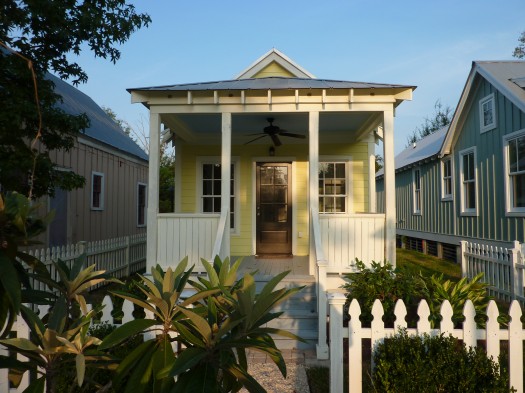
The attention “the little yellow house” attracted invited a lot of us to believe that the KC concept was poised to take off. Not only as a disaster housing strategy, but also as one potential solution to the growing demand for affordable living in infill locations for aging Boomers and career-launching Millennials.
From the get-go, FEMA resisted, understandably, it turned out, since paying for what was intended to become permanent housing was beyond its mandate to assure adequate, temporary emergency housing. FEMA argued it couldn’t legally take on the management of long-range housing solutions better left to HUD and other state and federal agencies.
Nevertheless, powerful congressional delegations from Mississippi and Louisiana engineered a one-time-only federal appropriation through FEMA of some $400 million for an Alternative Housing Pilot Program. Mississippi got the bulk of that money — more than $281 million — and spent it on what came to be called Mississippi Cottages (.pdf), which were designed partly with the help of design veterans of the Mississippi Renewal Forum.
The 3,500 units planned for Mississippi didn’t begin rolling out till 2007. But early in 2006, architect Bruce Tolar in Ocean Springs was already working with developer partners on pushing forward a model neighborhood that represented the Forum’s most ambitious hopes: A cluster of Katrina Cottages of various designs providing affordable, energy-efficient mixed-use units close enough to daily needs to make walking or biking a realistic option to driving. Cottage Square was born:
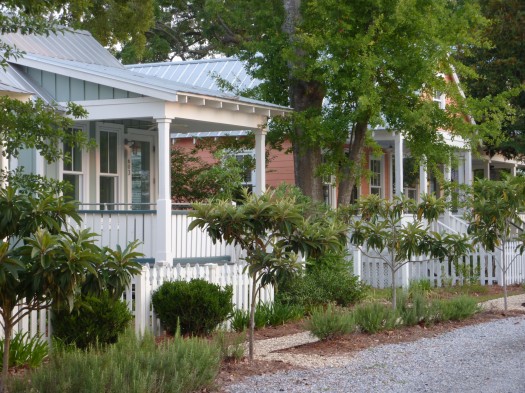
When the first manufactured one-bedroom Mississippi Cottages became available, Tolar was ready to drop then into a section of the Square reserved for them:
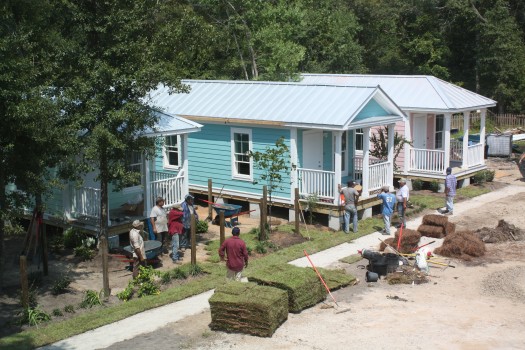
And here’s how the manufactured units looked once Tolar tricked out finishes and after landscaping matured:
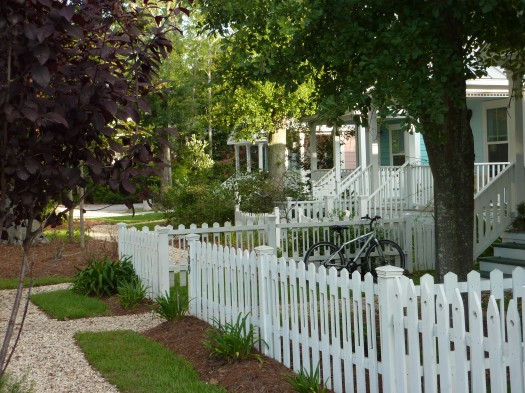
Inspired by Tolar’s model, Joe Cloyd, who was an aide to Governor Barbour and the go-to logistics guy during the 2005 Forum in Biloxi, teamed up with local developer Adam Dial to purchase an old trailer park next to Cottage Square and use Mississippi Cottages for a rental home cluster called Cottages at Oak Park:
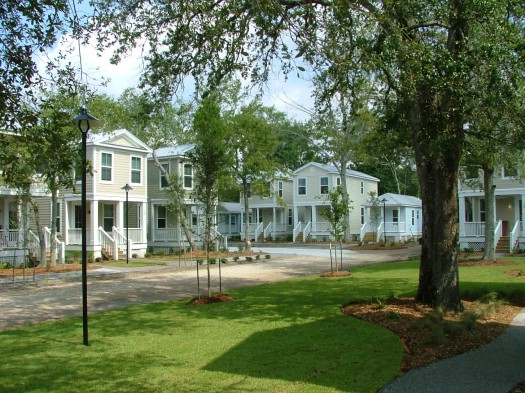
Later came a similar cluster from the same development team, this time built higher to honor flood zone elevations,in Pass Christian. Here’s that project at ribbon cutting:
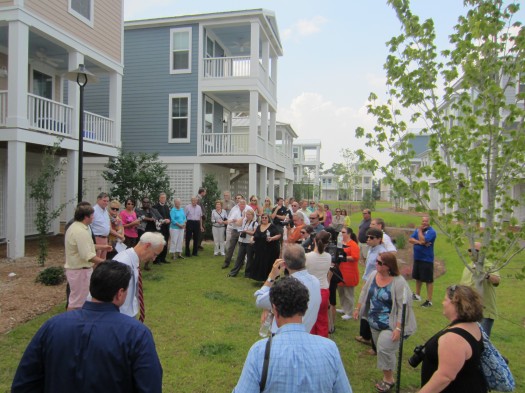
The two-bedroom versions you see perched at altitude in Pass Christian or above crawl space in the Cottage at Oak Park project are among those in the original Mississippi Cottage allotment. The Delaware Double in Mobile, designed by Tolar and finished on-site under a development contract with Cloyd and Dial, is a marriage of two of those units.
Tolar presents a fuller narrative of the slow advance of Katrina Cottages to Cottage Square and then to other model neighborhoods in this Lean Urbanism post.
There’s little doubt these three neighborhoods in Coastal Mississippi and the new affordable housing model on Delaware Street in Mobile represent the hopes of those who worked on Katrina Cottage designs in the Forum in 2005. But taken together, that’s less than 100 of the 3,500 Mississippi Cottage units. Even if there’s another 100 or so we don’t know about used in similar ways, that’s still only about six percent of the units available to demonstrate an alternative to business-as-usual housing policy.
Sold at auction, often at deep discounts, many are on scattered sites, surrounded and diminished by larger scale structures. Others are hidden in backyards as studios or granny flats. They’re used as hunting cabins somewhere in the boonies. Or worst of all, they’re arrayed in mobile home parks with site plans and finishing strategies that abandon the pretense of dignity.
So some obvious, grumpy questions:
If the whole Katrina Cottage thing was such a great idea, if KC designs attracted thousands of readers and video watchers in the months after the storm, if advocates convinced the feds to devote $400 million to a pilot program, and if the timing seemed so perfectly apt for an era in which changing demographics and economics are driving demand for affordable small-scale housing — if all that’s true, then why aren’t there hundreds of examples of cottage neighborhoods everywhere? And why has this taken so long?
Also, for good measure: Why haven’t the advantages of system building techniques — especially when it comes to building whole units or unit modules in factories — been better applied and advanced in the realm of affordable housing?
To the question of why didn’t the Katrina Cottage idea sweep the nation: Heck, the idea didn’t even sweep Coastal Mississippi. The Tolar-Cloyd-Dial neighborhoods took seven years to critical mass, while proposals to do something similar in other locations were blocked by local planning boards, elected officials and neighbors, even when units could be had for free or for greatly reduced costs over building on site.
Almost all of us associated with KC advocacy failed to appreciate the difficulty of changing the way business is usually done, whether we’re talking infrastructure planning, zoning, housing finance or construction. As disaster recovery researchers note, the push in the wake of the trauma is to get things back to the way they were as quickly as possible, even if the way things were may have contributed to the community’s ability to recover more quickly.
Car-dependent, suburban-style neighborhoods with homes three or four times the size of KC designs were the normal most folks were anxious to return to. To many, smaller implied settling for less; and manufactured housing, no matter how sophisticated the design or the quality of materials, translated to “trailer park.”
Moving zoning towards form-based codes and housing towards Katrina Cottage neighborhoods “would have been tough in a lot of these communities even before the storm,” says Joe Cloyd. “Immediately after Katrina, when leaders were constrained by all the stuff right in front of them, thinking about a Smart Code overlay or some other big policy change was just asking too much.
“It’s like what one of the local officials told me during the Forum discussions: ‘It’s hard to think about ways to drain the swamp when alligators are biting your ass.’”
There’s this, as well: The efficiencies of cottage neighborhood approaches are fully realized only in infill locations. What makes living in a 400 to 800-sq.-ft. home work is access to lots of choices beyond its walls: Close-by schools, work places, shopping, entertainment, transit. Which means infill lots. Which likely means higher land costs and neighbors suspicious of housing that doesn’t look like theirs. Especially rental housing. And even more especially, manufactured housing.
“It’s all about seeing it done right,” says Dave Betler, marketing and operations specialist with Next Step, a national non-profit that connects local and regional affordable housing organizations with factory-build homes companies. “Once people see it, they get it.”
So getting appealing models up and running became a key strategy for Bruce Tolar, Joe Cloyd and others on their development teams. Cottage Square made it easier to do the Cottages at Oak Park, which made it easier to do the Pass Christian project. All of which provided successful built examples for using Mississippi Cottages in Mobile.
Getting those models out of the ground in pricey infill locations has required an important innovation, public-private partnerships. In each of the successful projects after Cottage Square, development was helped by the participation of a well-established affordable housing non-profit and government support, in addition to a committed private developer.
“We prefer the public private partnership route right now,” says Cloyd, not only because there are others to offset costs necessary to do an infill neighborhood right, but also because these pioneering efforts, where downstream profits are not always as obvious as in typical development deals, require leaps of faith. Having an experienced, mission-driven non-profit to help with things like screening and training potential renters and attracting grants for added-value amenities reduces the risk factors.
Similarly, says Brandi Purvis, development director for Family Promise of Coastal Alabama “having a city like Mobile as a partner is huge.”
Before assuming a role in the Delaware Street project, Family Promise was working with homeless families in Mobile and establishing a relationship with the City, which owns the blighted property selected for the Delaware Double and has designated the broader neighborhood for redevelopment. For its part, the City cleaned up the site and beefed up attention to routine services like police patrols. Family Promise will identify families eligible for using the Double as transitional housing, counsel them in their responsibilities and manage the property.
With the good will, this single project inspires, the partners hope, opportunity expands for more units in the same redeveloping neighborhood and beyond.
“It’s definitely a win-win-win,” says Nigel Roberts, director of the Community and Housing Development Department.
For those of us who shared the initial excitement of the Katrina Cottage idea and presumed it would go forth and multiply, it seems an overlong struggle to get to win-win-win. But the idea is clearly, finally gaining traction.
Many potential benefits to come. Not the least of which may be the dose of humility this experience has supplied those of us who expected too much too soon.
The previous post in this series, “Katrina Ten Years After: And the band plays on,” can be found here.
If PlaceShakers is our soapbox, our Facebook page is where we step down, grab a drink and enjoy a little conversation. Looking for a heads-up on the latest community-building news and perspective from around the web? Click through and “Like” us and we’ll keep you in the loop.


